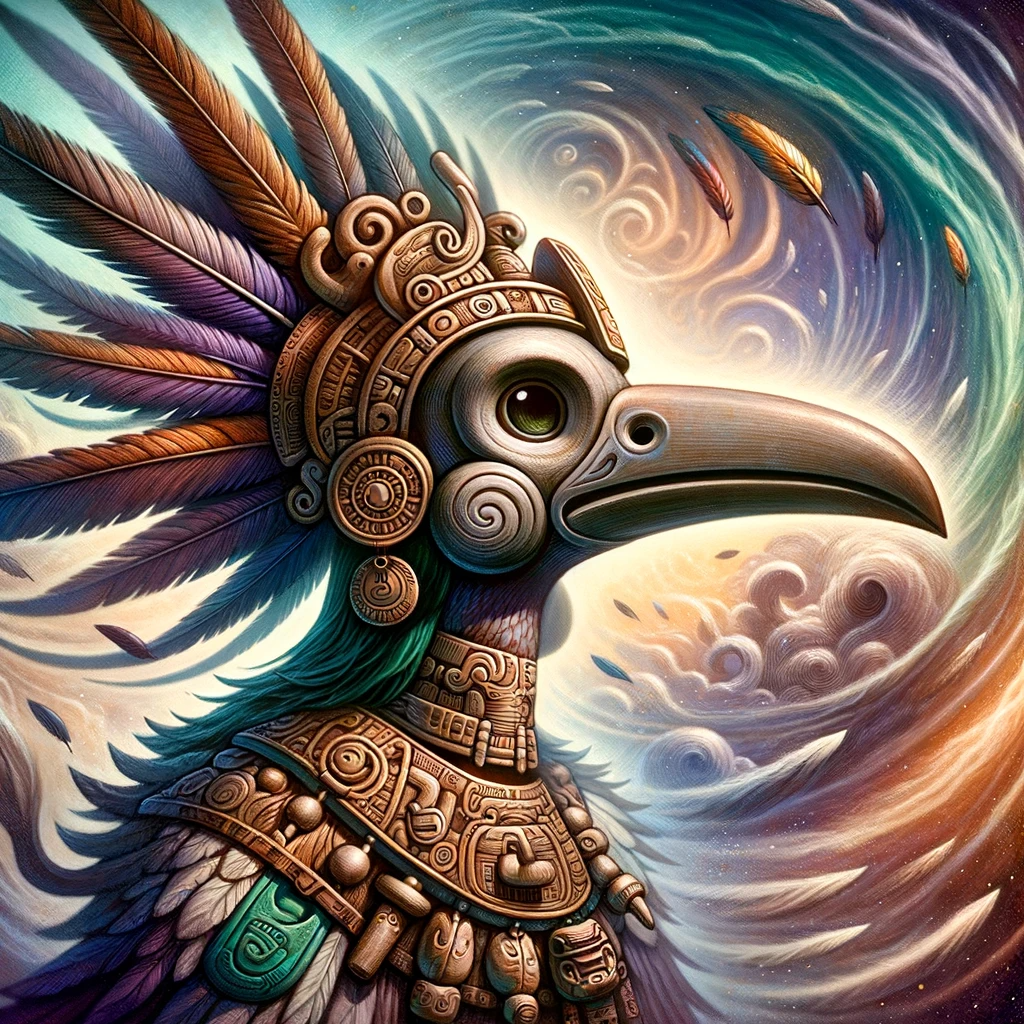
In the pantheon of Aztec mythology, one deity stands out for his unique representation and importance: Ehecatl, the god of wind. Revered by the Aztecs, Ehecatl played a crucial role in their cosmology, symbolizing the dynamic force of wind and its influence on life, weather, and even the heavens.
Origins and Symbolism
Ehecatl, whose name literally means "wind" in the Nahuatl language, is often associated with the cardinal directions and the breath of life. He is considered a manifestation of Quetzalcoatl, one of the major deities of the Aztec pantheon, embodying the gentler aspects of this Feathered Serpent deity. Ehecatl represents the invisible, life-giving force of the wind, an element essential for the survival of all living things.
Iconography and Worship
In Aztec art and architecture, Ehecatl is typically depicted with a distinctive black mask featuring a long, protruding nose, symbolizing the rushing of the wind. This unique representation made him easily recognizable among the pantheon of Aztec gods. His temples, often circular to represent the movement of the wind, were widespread, reflecting his importance. The most famous of these is the Templo de Ehecatl in the pre-Hispanic city of Tlatelolco, where the circular base and conical elevation echo the swirling motion of the wind.
Mythology and Influence
Ehecatl played a significant role in Aztec creation myths. He was believed to have breathed life into the sun and the moon, setting them into motion in the sky. His breath was seen as the vital force that animated the universe, emphasizing his integral role in the cycle of life and death. Ehecatl also featured in tales concerning the origins of humanity and the natural world, often serving as a messenger between the earth and the divine realm.
Rituals and Ceremonies
The Aztecs held numerous rituals and ceremonies in honor of Ehecatl. These often involved offerings of quails, incense, and other items believed to please the wind god. Priests and worshipers would invoke his aid for favorable winds in agriculture, particularly in the context of maize cultivation, which was central to Aztec life and economy. Additionally, Ehecatl was called upon by sailors and travelers for safe journeys, as the wind was a crucial element in their voyages.
Legacy
The reverence of Ehecatl highlights the Aztecs' deep connection with nature and their understanding of its vital forces. Today, his legacy lives on in Mexican culture and history, symbolizing the enduring power and mystery of the wind. Ehecatl's influence extends beyond mere mythology, reflecting a broader appreciation for the natural world's intricate and life-sustaining systems.
In conclusion, Ehecatl, the Aztec god of wind, stands as a testament to the rich spiritual and cultural heritage of the Aztec civilization. His depiction and worship underline the importance of natural elements in Aztec society and offer a window into their complex belief systems and cosmology. As we study Ehecatl and his role in Aztec mythology, we gain a deeper appreciation for the sophistication and depth of pre-Columbian cultures in the Americas.
Origins and Symbolism
Ehecatl, whose name literally means "wind" in the Nahuatl language, is often associated with the cardinal directions and the breath of life. He is considered a manifestation of Quetzalcoatl, one of the major deities of the Aztec pantheon, embodying the gentler aspects of this Feathered Serpent deity. Ehecatl represents the invisible, life-giving force of the wind, an element essential for the survival of all living things.
Iconography and Worship
In Aztec art and architecture, Ehecatl is typically depicted with a distinctive black mask featuring a long, protruding nose, symbolizing the rushing of the wind. This unique representation made him easily recognizable among the pantheon of Aztec gods. His temples, often circular to represent the movement of the wind, were widespread, reflecting his importance. The most famous of these is the Templo de Ehecatl in the pre-Hispanic city of Tlatelolco, where the circular base and conical elevation echo the swirling motion of the wind.
Mythology and Influence
Ehecatl played a significant role in Aztec creation myths. He was believed to have breathed life into the sun and the moon, setting them into motion in the sky. His breath was seen as the vital force that animated the universe, emphasizing his integral role in the cycle of life and death. Ehecatl also featured in tales concerning the origins of humanity and the natural world, often serving as a messenger between the earth and the divine realm.
Rituals and Ceremonies
The Aztecs held numerous rituals and ceremonies in honor of Ehecatl. These often involved offerings of quails, incense, and other items believed to please the wind god. Priests and worshipers would invoke his aid for favorable winds in agriculture, particularly in the context of maize cultivation, which was central to Aztec life and economy. Additionally, Ehecatl was called upon by sailors and travelers for safe journeys, as the wind was a crucial element in their voyages.
Legacy
The reverence of Ehecatl highlights the Aztecs' deep connection with nature and their understanding of its vital forces. Today, his legacy lives on in Mexican culture and history, symbolizing the enduring power and mystery of the wind. Ehecatl's influence extends beyond mere mythology, reflecting a broader appreciation for the natural world's intricate and life-sustaining systems.
In conclusion, Ehecatl, the Aztec god of wind, stands as a testament to the rich spiritual and cultural heritage of the Aztec civilization. His depiction and worship underline the importance of natural elements in Aztec society and offer a window into their complex belief systems and cosmology. As we study Ehecatl and his role in Aztec mythology, we gain a deeper appreciation for the sophistication and depth of pre-Columbian cultures in the Americas.